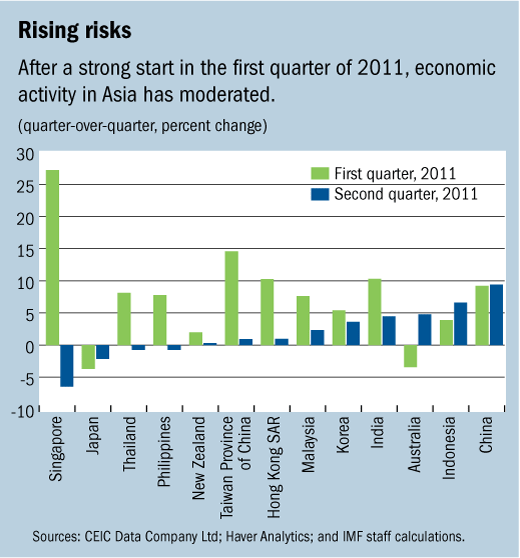
Typical street scene in Santa Ana, El Salvador. (Photo: iStock)
IMF Survey: Asian Growth Faces Headwinds From Global Uncertainty
October 13, 2011
- European financial turbulence, U.S. slowdown could spill over to Asia
- Policymakers face delicate balancing act with lingering overheating pressures
- Rebalancing would reduce vulnerability, help promote inclusive growth
With increasing financial turbulence in the euro area and growth slowing in the United States, Asia is facing rising risks to its growth, says the IMF in its latest Regional Economic Outlook for the Asia and Pacific region.

Outdoor market in Malaysia. As food and energy prices moderate, the IMF expects inflation to recede after 2011. But risks remain (photo: Steve Vidler/Corbis)
REGIONAL ECONOMIC OUTLOOK
GDP growth across Asia is forecast to average 6¼ percent in 2011, rising to 6¾ percent next year, moderately lower than envisaged 6 months ago, and in line with the weaker global outlook.
“Risks for Asia are decidedly tilted to the downside,” suggest the authors of the twice-annual report released in Tokyo.
Although far from the epicenter of the crisis, Asia remains vulnerable to further trade and financial shocks given its high degree of integration.
In addition to a drop in global demand for Asian exports, foreign investors could retrench from the region, reversing their large positions. European banks could reduce cross border lending, causing credit flows to dry up.

Nevertheless, given the financial, corporate, and public sector balance sheet strengths built over the last decade, Asia has buffers which should help it navigate this global environment.
The region has also accumulated large foreign reserves. Many countries still have policy space to support economic activity in the event the risks materialize.
Policymaking more complex as overheating risks remain
The IMF expects inflation to recede after peaking in 2011, as food and energy prices moderate, but cautions that inflation remains elevated in many countries.
In countries where overheating pressure remains high, and monetary conditions continue to be accommodative, the report suggests that the ongoing return to a more neutral monetary stance is appropriate.
“Elevated inflation risks in many countries call for a continuation of macro-policy normalization. However, against the backdrop of unusual uncertainty, a pause in tightening is warranted, particularly in countries where inflation pressures have been contained and that are highly sensitive to a global slowdown,” says the report.
Many Asian countries have also been normalizing their fiscal stances following the stimulus implemented in response to the global downturn. If the recovery in the region continues, the report says this normalization should be allowed to run its course.
Given the combination of heightened downside risks and lingering overheating pressures, policymakers confront a delicate balancing act. They need to buffer the economy from softening exports, while containing goods and asset price inflation in some economies. Also policymakers need to be nimble, and rapidly reverse course if necessary.
More durable and inclusive growth key
The protracted fragility in the global economy forcefully confirms that Asia should make rapid progress on rebalancing to shield it from external vulnerabilities and cushion the impact on growth.
As the 2008 crisis clearly demonstrated, despite increasing regional trade integration, Asia remains highly exposed to fluctuations in demand from outside the region. In addition to structural reforms to boost consumption and investment, reprioritization of fiscal spending is imperative. This would create the room to increase spending in two key areas: infrastructure and the social sector.
Such policies would also improve the quality of growth and make it more equitable. Despite fast growth and progress in poverty reduction, income inequality in Asia has increased over the last decade—and by more than it has done in other regions.
“Continued high growth alone will not be sufficient to address emerging social imbalances and policy measures are needed to make growth in Asia more inclusive,” suggests the report, which goes on to say that Asia’s pursuit of inclusive growth could be promoted through further economic rebalancing.
Key elements of a strategy to reduce the share of vulnerable households in Asia would include better social safety nets and more investment in health and education. These measures to stem inequality could have the added advantage of strengthening domestic demand and making the region’s growth momentum more resilient to external shocks.


